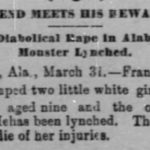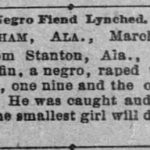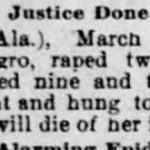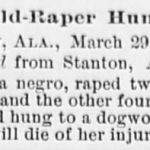About the Case
Date: March 29, 1890
County: Chilton
Victim(s): Frank Griffin
Sex of Victim(s):male
Case Status: attempted
Frank Griffin
March 29, 1890
Stanton, AL

On March 29, 1890 Frank Griffin, a black man of unknown age, was lynched near Stanton, AL., in the rural farming community of Ocmulgee (Oakmulgee) in Chilton County.[1] Three days earlier, on the morning of March 26, 1890, he allegedly “waylaid” and “outraged” “two little white girls” walking to school.[2] (White reporters commonly used these terms in stories about lynching to tell their readers that white female victims had been overpowered and raped by a black man).[3] The girls were not sisters and never named in an article, but their fathers were: George Moore and Miles Lally.[4] Griffin fled Oakmulgee and hid for three days from a posse of white law enforcement officers and other white men until they found him on March 29 near the Cahaba River, which is approximately 16 miles west of Oakmulgee.[5] After the officers placed him in custody they brought him back to the “scene of the crime” in Oakmulgee.[6] At this point the narrative of events becomes murky. No one formally accused Griffin of the rapes but the police kept him over night, apparently outside in a nearby wooded area. It is unclear why he was not taken directly to jail.[7] During the night a mob of white men overpowered the guards, grabbed Griffin, and took him to a nearby dogwood tree, and placed a noose around his neck. They then threw the other end of the rope over a tree limb and asked him to confess what he had done, which he supposedly did. The mob then hanged Griffin and delivered “a volley of buckshot [that] finished the story”.[8] A man named D.A. Rogers later confirmed the lynching to the Birmingham Daily Age-Herald.[9]
Frank Griffin lived on a property called “Griffin Place.”[10] He may have owned the property himself, though I discovered no corroborating land records. It is possible that he descended from family who were formally enslaved by the Griffins and continued to live and work on the land of their former masters. The Griffin Place was about 13 miles west of Stanton in the neighborhood of Oakmulgee. Due to the lack of balanced reporting and the non-existence of the 1890 census it is difficult to tell where Frank Griffin came from or where his family went after the lynching. The 1880 census does not include Frank Griffin nor any other black Griffins. Most likely he was a sharecropper or farmer in the area, as nearly were all residents. The only white names in the articles are the fathers of the two girls, George Moore and Miles Lally, I could not find them in the census or local records. No members of the mob were identified.
The majority of the information I have gained from this case has come from visiting Oakmulgee, scanning censuses, and studying white newspapers from 1890. The original news article in the Daily Age-Herald proved the most helpful and beneficial.[11] It is the article most other articles was based on, including ones published as far away as Canada. Although stories about the alleged crime spread quickly, it always assumed Griffin was guilty and deserved his fate. Little was written about Griffin as a person—his age, family, and connections to the community
The reason to remember Frank Griffin is simple: he is a human being. This is enough. Facts and truth when freely given to the public have the potential to shape the future. Truth must be recovered. Truth must be told. But in order to uncover the truth work must be done. In order for work to be done someone must care. The people who care about these issues have long been people who were not given much power in local life. The truth is now being uncovered and the truth is cared about in people of this generation. The information is hard to find but it is there. It must simply be uncovered.
When I think of Frank Griffin now, after researching him for nearly four months, I feel like I had a friend who died and I did not get to see him one final time. There is no closure. There are no final goodbyes. His family had no final goodbyes. Griffin had dreams and ambitions. All I know about him is the crime he was accused of and how he died. It does not seem fair for this to be a reality for someone but it was for Griffin and over 4400 other individuals like him. Frank Griffin died 129 years ago but his life has changed mine forever. He has pushed me to fight for the voices who were never heard and are still not today. He is a fire within to push through the pain and hardship of social justice work and continue on. This is exactly what I want to do now—discover ways to reconcile the things that have for so long been a reality for a large population of people.

[1] “A Negro Lynched.” The Weekly Advertiser, April 3, 1890.
[2] “A Negro Lynched.” The Jacksonville Republican, April 5, 1890.
[3] “A Negro Lynched.” The Jacksonville Republican, April 5, 1890.
[4] “A Negro Lynched.” The Jacksonville Republican, April 5, 1890.
[5] “To a Dogwood Tree.” Daily Age Herald, 29 March, 1890.
[6] “To a Dogwood Tree.” Daily Age Herald, 29 March, 1890.
[7] “A Negro Lynched.” The Jacksonville Republican, April 5, 1890.
[8] “A Negro Lynched.” The Weekly Advertiser, April 3, 1890.
[9] “To a Dogwood Tree.” Daily Age Herald, 29 March, 1890.
[10] “To a Dogwood Tree.” Daily Age Herald, 29 March, 1890.
[11] “To a Dogwood Tree.” Daily Age Herald, 29 March, 1890.
Featured Sources | |
|---|---|

|
A Fiend Meets His RewardType: Newspaper “A Fiend Meets His Reward.” The Winnipeg Tribune (Winnipeg, MB), March 31, 1890. |

|
Negro Fiend LynchedType: Newspaper “Negro Fiend Lynched.” Fort Worth Daily Gazette (Fort Worth, TX), March 31, 1890. |

|
Justice DoneType: Newspaper “Justice Done.” The Record-Union (Sacramento, CA), March 30, 1890. |

|
A Child-Raper Hung UpType: Newspaper “A Child-Raper Hung Up.” The Sunday Herald (Washington, DC), March 30, 1890. |
“To A Dogwood Treet.” Daily Age Herald (Birmingham, AL), March 30, 1890.
“Negro Fiend Lynched.” Fort Worth Daily Gazette (Fort Worth, TX), March 31, 1890.
n.t. Our Mountain Home (Talladega, AL), April 02, 1890.
n.t. The Marion Times Sun (Marion, AL), April 02, 1890.
n.t. Brooklyn Daily Eagle (New York, NY), March 31, 1890.
n.t. The Moulton Advertiser (Moulton, AL), April 03, 1890.
“Justice Done.” The Record-Union (Sacramento, CA), March 30, 1890.
“Items of Interest Gathered From Over this Busy State.” The Sumter County Sun (Livingston, AL), April 03, 1890.
“Hung to a Dogwood Tree.” The Knoxville Times (Knoxville, AL), March 30, 1890.
“A Rape Fiend Lynched.” The Wilmington Messenger (Wilmington, NC), March 30, 1890.
“A Negro Raper Lynched.” The Salt Lake Herald (Salt Lake City, UT), March 30, 1890.
“A Negro Rape Fiend Lynched.” Los Angeles Herald (Los Angeles, CA), March 30, 1890.
“A Negro Lynched.” The Weekly Advertiser (Montgomery, AL), April 03, 1890.
“A Negro Lynched.” The Jacksonville Republican (Jacksonville, AL), April 05, 1890.
“A Fiend Meets His Reward.” The Winnipeg Tribune (Winnipeg, MB), March 31, 1890.
“A Child-Raper Hung Up.” The Sunday Herald (Washington, DC), March 30, 1890.